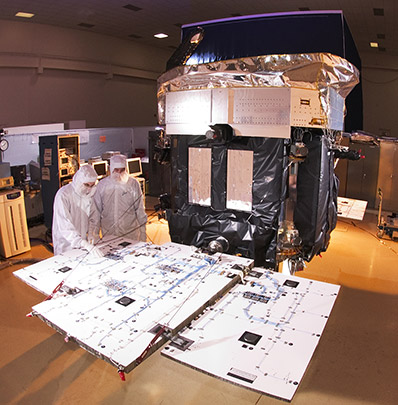
Clouds, Weather & Climate Data
In Three Dimensions
How do clouds affect climate and weather? With capabilities 1,000 times more sensitive than typical weather radar, CloudSat uses millimeter-wavelength radar to measure the altitude and properties of clouds.
With CloudSat data, scientists have a never-before-seen 3D perspective of Earth’s clouds that answers questions about how they form, evolve and affect our weather, climate and freshwater supply. This data provides the first global measurements of cloud properties that will help scientists compile a database of cloud measurements to feed into global climate and weather prediction models.
CALIPSO
NASA CALIPSO
Colorado State University CloudSat

What We Did
Spacecraft provider, integrations & test lead
We built the CloudSat spacecraft and tested and integrated the Cloud Profiling Radar payload, built by NASA’s Jet Propulsion Laboratory. We also tested and integrated other hardware from the Canadian Space Agency.
Both CloudSat and its launch partner CALIPSO are part of a constellation of spacecraft called the "A-Train," including Aqua, Aura and PARASOL, dedicated to studying the Earth’s weather and environment. CloudSat and CALIPSO launched April 28, 2006 from Vandenberg Air Force Base into a polar orbit at an altitude of 438 miles (705 km). In 2018, CALIPSO and Cloudsat left the A-Train and were lowered about 10 miles into their own “C-Train.” The two satellites have resumed working and are delivering collocated measurements.
In 2007, NASA awarded our CloudSat team with a Group Achievement Award for outstanding work in the design, development, assembly, integration, test, launch and early orbit operations of the CloudSat spacecraft.
An Award-Winning Solution
Daylight-only operation
After surpassing its design life of three years, CloudSat’s aging batteries began to lose power in April 2011. We invented a way that allowed the spacecraft to continue operating and collect data in daylight-only mode. For its mission-saving efforts, our CloudSat team won a NASA Exceptional Public Achievement Award.
In its out-years, CloudSat has been growing in importance to the international weather community. Some 56 nations are regularly using its science data and have downloaded over 10 million files, with each file representing one orbit’s worth of data.
Both CloudSat and CALIPSO satellites have been on orbit for nine years. More than 500 peer-reviewed scientific papers have been written based on CloudSat data; CALIPSO has more than 1,000 to date. Both missions were built on cost-capped budgets for the Earth System Science Pathfinder Program and have delivered high value science far exceeding mission design life.
